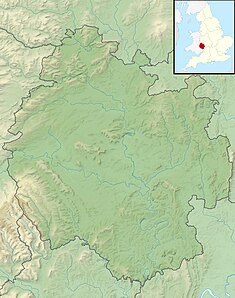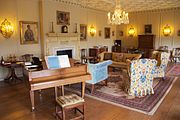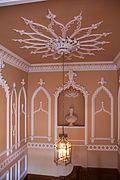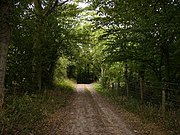
Wimpole Estate is a large estate containing Wimpole Hall, a country house located within the civil parish of Wimpole, Cambridgeshire, England, about 8+1⁄2 miles southwest of Cambridge. The house, begun in 1640, and its 3,000 acres (12 km2) of parkland and farmland are owned by the National Trust. The estate is regularly open to the public and received over 335,000 visitors in 2019. Wimpole is the largest house in Cambridgeshire.

Eastnor Castle, Eastnor, Herefordshire, is a 19th-century mock castle. Eastnor was built for John Cocks, 1st Earl Somers, who employed Robert Smirke, later the main architect of the British Museum. The castle was built between 1811 and 1820. Major schemes of interior decoration were carried out by A.W.N. Pugin in 1849–1850. Eastnor remains a private home, and is currently the residence of James Hervey-Bathurst, the grandson of Arthur Somers-Cocks, 6th Baron Somers. It is a Grade I listed building. The surrounding gardens and parkland are designated Grade II*.

Blaise Castle is a folly built in 1766 near Henbury in Bristol, England. The castle sits within the Blaise Castle Estate, which also includes Blaise Castle House, a Grade II* listed 18th-century mansion house. The folly castle is also Grade II* listed and ancillary buildings including the orangery and dairy also have listings. Along with Blaise Hamlet, a group of nine small cottages around a green built in 1811 for retired employees, and various subsidiary buildings, the parkland is listed Grade II* on the Register of Historic Parks and Gardens of special historic interest in England.

Ganarew is a village and small civil parish in south Herefordshire, England near the River Wye and the border with Wales. The village is located 0.62 miles (1.00 km) southwest of the village of Whitchurch on the main A40 road, and lies within the electoral ward of Kerne Bridge. The village is about 2 miles (3.2 km) from Monmouth and 8 miles (13 km) from Ross-on-Wye. It contains the Church of St Swithin and Ganarew Manor.

Thomas Andrew Knight (1759–1838), FRS, of Elton Hall in the parish of Elton in Herefordshire and later of Downton Castle, was a British horticulturalist and botanist. He served as the 2nd President of the Royal Horticultural Society (1811–1838).

Treago Castle is a fortified manor house in the parish of St Weonards, Herefordshire, England. Built c. 1500, it was recorded as a Grade I listed building on 30 April 1986—based on its extant medieval architecture, quadrangle courtyard layout and defensive wall corner towers. Digging on the site revealed solid bedrock, conflicting rumours of a previously filled moat.

Ravensworth Castle is a ruinous Grade II* listed building and a Scheduled Ancient Monument situated at Lamesley, Tyne and Wear, England. The building has been destroyed and rebuilt a number of times, and was the seat of the Ravensworth barons, the Liddells.

Hampton Court Castle, also known as Hampton Court, is a castellated country house in the English county of Herefordshire. The house is in the parish of Hope under Dinmore 4 miles (6.4 km) south of Leominster and is a Grade I listed building, which is the highest category of architecture in the statutory protection scheme.
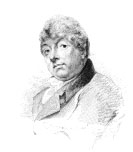
Thomas Johnes FRS was a Member of Parliament, landscape architect, farmer, printer, writer and social benefactor. He is best known for his development of the Hafod Estate in Wales.

Downton Castle is a grade I listed 18th-century country house in the parish of Downton on the Rock in Herefordshire, England, situated about 5 miles (8.0 km) west of Ludlow, Shropshire.

Rode Hall, a Georgian country house, is the seat of the Wilbraham family, members of the landed gentry in the parish of Odd Rode, Cheshire, England. The estate, with the original timber-framed manor house, was purchased by the Wilbrahams from the ancient Rode family in 1669. The medieval manor house was replaced between 1700 and 1708 by a brick-built seven-bay building; a second building, with five bays, was built in 1752; the two buildings being joined in 1800 to form the present Rode Hall.
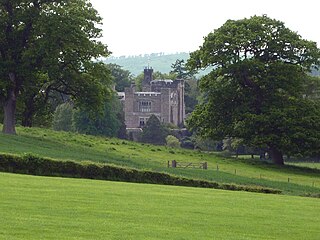
Thurland Castle is a country house in Lancashire, England which has been converted into apartments. Surrounded by a moat, and located in parkland, it was originally a defensive structure, one of a number of castles in the Lune Valley. It is recorded in the National Heritage List for England as a designated Grade II* listed building. Situated between the villages of Cantsfield and Tunstall the castle is built on a mound and is encircled by a moat. The River Greta runs to the south and the Cant beck to the north.

Canon Frome is a hamlet and small rural parish on the River Frome, 5 miles northwest of Ledbury, Herefordshire, England with a population of 139. Its most notable feature is Canon Frome Court which is a Grade II listed large red brick country house. The house was originally a sixteenth century moated manor house but was extensively rebuilt, incorporating earlier parts of the building, in 1786 and again in 1868. It was for 300 years the ancestral home of the Hopton family. It now forms a cohousing community.

Shotover Park is an 18th-century country house and park near Wheatley, Oxfordshire, England. The house, garden and parkland are Grade I-listed with English Heritage, and 18 additional structures on the property are also listed. Shotover House, its gardens, parkland and the wider estate are privately owned by the Shotover Trust. Shotover Park which lies on the north and east slopes of Shotover hill should not be confused with the more recently named Shotover Country Park, which is a public park and nature reserve on the southwest slopes of Shotover hill managed by Oxford City Council.

Richard Knight (1659–1745), of Downton Hall, in the parish of Downton on the Rock in Herefordshire, England, was a wealthy ironmaster who operated the Bringewood Ironworks, on the Downton estate, and founded a large fortune and family dynasty.

Homme House is an 18th-century country house in Much Marcle, Herefordshire, UK. Primarily built of brick, it is now used as a wedding venue and is a Grade II* listed building.

Eardisley Park is a country house and estate to the southwest of the village of Eardisley in Herefordshire, England, and approximately 14 miles (23 km) north-west of Hereford.

Croft and Yarpole is a civil parish in the county of Herefordshire, England, and is 17 miles (27 km) north from the city and county town of Hereford. The closest large town is the market town of Leominster, 4.5 miles (7 km) to the south. Within the parish is the National Trust property of Croft Castle and Parkland.

Eye, Moreton and Ashton is a civil parish in the county of Herefordshire, England. The parish is 15 miles (24 km) north from the city and county town of Hereford. The closest large town is the market town of Leominster, 3 miles (5 km) to the south. Within the parish is the National Trust property of Berrington Hall, and the villages of Eye, Moreton, and Ashton.

Edvin Loach and Saltmarshe is a civil parish in north-east Herefordshire, England, and is approximately 15 miles (24 km) north-east from the city and county town of Hereford. The nearest town is Bromyard, 2.5 miles (4 km) to the south-west. Within the parish is a George Gilbert Scott built parish church in the virtually depopulated settlement of Edvin Loach, and the repurposed site of the demolished Saltmarshe Castle.

